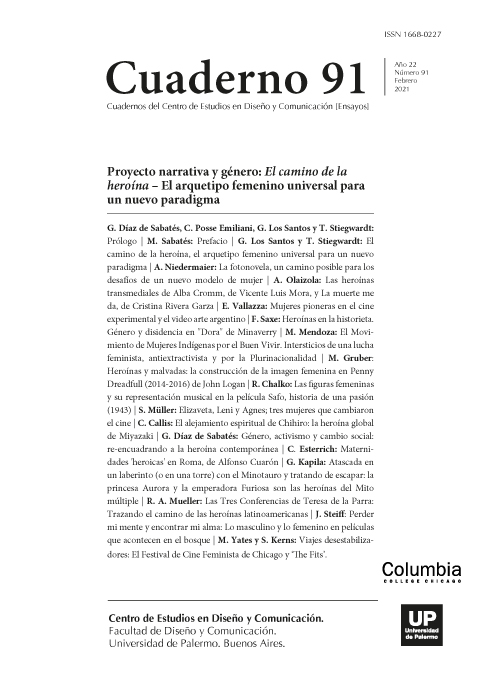Mujeres pioneras en el cine experimental y el video arte argentino
Resumen
El presente ensayo indagará sobre el rol protagónico de mujeres realizadoras, programadoras y curadoras de cine experimental y video arte argentino. Se analizarán los trabajos tanto en la realización de obra audiovisual como también en sus facetas de programadoras de salas, museos, centros culturales, que han dedicado espacios a la difusión del audiovisual experimental argentino.
Si bien se nombrarán varios casos, se analizarán puntualmente los momentos históricos de gestación y consolidación del cine experimental y video arte en Argentina. Un punto en común, más allá de los diversos contextos políticos y culturales, es el activismo de estas realizadoras en relación a los derechos de las mujeres en el medio audiovisual. Los nombres y casos de mujeres desatacadas en ambos son los siguientes.
Marie-Louise Alemann, una de las pioneras del cine experimental, formó el “Grupo Cine Experimental Argentino” en la sede del instituto Goethe y estuvo a cargo de la programación de la Cinemateca entre 1979 y 1985, espacio donde se podían ver y debatir los films de Rainer Werner Fassbinder, Alexander Kluge, Edgar Reitz o Wim Wenders. Nació en Alemania en 1927 y se radicó en el país en 1949. Se desempeñó como fotógrafa, periodista, actriz teatral y artista plástica y hacia 1967 –cuando la dictadura militar de Juan Carlos Onganía comenzaba a cercar al Instituto Di Tella– participó junto a sus amigos Walter Mejía y Narcisa Hirsch de un happening en la puerta de la sala donde se estrenaba Blow Up, de Michelangelo Antonioni. Aquella intervención en la vía pública fue documentada por Raymundo Gleyzer, en lo que se considera fue una de los pocas coincidencias entre lo que por entonces eran las vanguardias políticas y estéticas.
Narcisa Hirsch, pionera del cine experimental argentino, participó del mismo grupo. El cine “es solo luz proyectada, movimiento puro” sostenía vehementemente Narcisa Hirsch en una entrevista (Paparella, 1995: 34). Retomando una de las premisas básicas del modernismo pictórico. Hirsch proponía concentrarse en la propia esfera de materiales y significación del cine como medio; en su “esencia”. El cine experimental presentaba su propia materia, construía su objeto sin ningún tipo de intención narrativa o diegética.
Por el lado del video arte, en otro contexto histórico y cultural, fuertemente ligado a los avances técnicos y a la masividad de las cámaras videograbadoras, analizaremos el caso de Graciela Taquini. En relación a la figura de Graciela Taquini, se puede mencionar que ha sido y continúa siéndolo hasta hoy, una figura clave en la difusión y exhibición del video arte argentino. Es una artista y curadora argentina que ha desarrollado la mayor parte de su producción artística en el área del video experimental monocanal. Sus obras han recibido diferentes premios, entre ellos el Premio de la Asociación de Críticos de Arte de la Argentina al mejor guion, el Primer Premio del Festival Videobrasil, y en 2005 el Premio a la Acción Multimedia, Asociación Argentina de Críticos de Arte.
Ha sido apodada "la tía del videoarte argentino" por su temprana participación e interés en dicha disciplina. En 2012 recibió la Premio Konex de Platino en Video Arte. Es miembro de número de la Academia Nacional de Bellas Artes. Finalmente, y en relación al uso de los nuevos medios, se reflexiona sobre un grupo de mujeres realizadoras y gestoras culturales dedicadas al cine y video experimental, se mencionará el caso de AREA Asociación de realizadores experimentales audiovisuales. Si bien no es un grupo exclusivamente femenino, cuenta con una comisión de género en el que la problemática de la mujer en el cine y en el audiovisual experimental es ampliamente abordada, en un contexto contemporáneo.
Citas
Giunta, A. (2013), “Narcisa Hirsch. Portraits” en Alternativas; vol. 1 p. 1 – 19, Ohio. En línea: http://alternativas.osu.edu/es/issues/autumn-2013/debates/giunta.html (recuperado: 16-06-2017) Narcisa Hirsch. Comp.: Sayago Victoria, Buenos Aires, Ed. MQ2*.
Marín, P. (2010) “La estructura presente. Narcisa Hirsch y el punto de quiebre del cine experimental en Argentina” en Narcisa. Catálogo de obra. Comp. Alejandra Torres, Buenos Aires, Casa Nacional del Bicentenario.
Paparella A. (1995), “Almuerzo en la hierba. Entrevista con Narcisa Hirsch sobre el cine experimental argentino”, en Narcisa. Catálogo de obra. Comp. Alejandra Torres, Buenos Aires, Casa Nacional del Bicentenario.
Taquini, G. “Del mito de Narciso al mito de Proteo, un diálogo informal con Narcisa Hirsch”, en Narcisa. Catálogo de obra. Comp. Alejandra Torres, Buenos Aires, Casa Nacional del Bicentenario.
Torres, A. (2010) “Ver (se) mirar a la cámara. Entrevista a Narcisa Hirsch” en Narcisa. Catálogo de obra. Comp. Alejandra Torres, Buenos Aires, Casa Nacional del Bicentenario.
Taquini, G. (2008) Video en Latinoamérica. Una historia crítica, Laura Baigorri (ed.) Brumaria n.10, AECID, Madrid.
Torres, A.; Garavelli, C. (2014) ¿Qué es lo experimental del cine y video experimental argentino?, IFOMAGIA n°9.
Textos Recuperados en Octubre y Noviembre de 2018 de http://www.bim.com.ar/
Textos Recuperados en Octubre y Noviembre de 2018 de http://asaeca.org/
Toro, K. (2012) “Marie Louise Alemann y el cine experimental argentino” en Ensayos sobre la Imagen. Edición XI. Año VIII, Vol. 48, Agosto 2012, Buenos Aires, Creación y Producción en Diseño y Comunicación Nº48.
Los autores/as que publiquen en esta revista ceden los derechos de autor y de publicación a "Cuadernos del Centro de Estudios de Diseño y Comunicación", Aceptando el registro de su trabajo bajo una licencia de atribución de Creative Commons, que permite a terceros utilizar lo publicado siempre que de el crédito pertinente a los autores y a esta revista.


